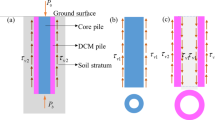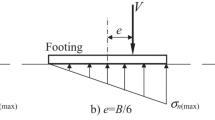Abstract
The bearing capacity of shallow foundations on geocell-reinforced sand (GRS) depends not only on the soil characteristics but also on the geometries and properties of geocell. The geometry characteristics of GRS comprise height, length and cell aperture size of geocell as well as the sand layer thickness engaged between footing and GRS layer. Using the design-of-experiments (DOE) method the trends of bearing capacity ratio (BCR) as a function of selected geometry parameters of geocell are systematically visualized. Furthermore, trends of BCR as a function of geocell-selected geometry parameters are analysed. To this end, the study deploys the response surface methodology (RSM) to identify several configurations of geocell by conducting only twenty-seven laboratory tests. The results show that the DOE-RSM method gives an efficient interpretation of the variable’s interaction while it lessens the number of tests. In addition, it has been found that the geocell height is the most influential parameter on BCR of footings on GRS. Moreover, an interaction between geocell aperture size and geocell height is recognised. The results are formulated and compared with the literature, resulting in good agreement.
















Similar content being viewed by others
Data Availability
All data, models, or code that supports the findings of this study is available from the corresponding author upon reasonable request.
References
Antony J (2014) Design of experiments for engineers and scientists. Elsevier, Amsterdam
ASTM D4885-01 (2018) Standard test method for determining performance strength of geomembranes by the wide strip tensile method book of standards volume: 04.13. https://doi.org/10.1520/D4885-01R18
ASTM D624-00 (2020) Standard test method for tear strength of conventional vulcanized rubber and thermoplastic elastomers. Book of standards volume: 09.01. https://doi.org/10.1520/D0624-00R20
Babu GS, Srivastava A (2008) Response surface methodology (RSM) in the reliability analysis of geotechnical systems. In: The 12th international conference of international association for computer methods and advances in geomechanics, pp 4147–4165
Babu GS, Srivastava A (2007) Reliability analysis of allowable pressure on shallow foundation using response surface method. Comput Geotech 34(3):187–194
Baecher GB, Christian JT (2005) Reliability and statistics in geotechnical engineering. Wiley, Baltimore
Bhattacharya S (2021) Central composite design for response surface methodology and its application in pharmacy. In: Kayaroganam P (ed) Response surface methodology in engineering science. Intech Open, London
Box GE, Draper NR (1987) Empirical model-building and response surfaces, vol 424. Wiley, New York
Briaud JL, Jeanjean P (1994) Load settlement curve method for spread footings of sand. In: Vertical and horizontal deformations of foundations and embankments. ASCE, pp 1774–1804
Chambers, J. M. (2018). Graphical methods for data analysis. Chapman and Hall/CRC.
Dash SK, Krishnaswamy NR, Rajagopal K (2001) Bearing capacity of strip footings supported on geocell-reinforced sand. Geotext Geomembr 19:235–256
Fazeli Dehkordi P, Karim UFA (2020) Behaviour of circular footings confined by rigid base and geocell reinforcement. Arab J Geosci 13(20):1–12
Fazeli Dehkordi P, Karim UFA, Ghazavi M, Ganjian N (2019a) Stochastic analysis of the capacity of two parallel footings on a thin sand layer. Proc Inst Civil Eng Geotech Eng 172(4):355–364
Fazeli Dehkordi P, Ghazavi M, Ganjian N, Karim UF (2019b) Effect of geocell-reinforced sand base on bearing capacity of twin circular footings. Geosynth Int 26(3):224–236
Fazeli Dehkordi P, Ghazavi M, Ganjian N, Karim UFA (2021a) Parametric study from laboratory tests on twin circular footings on geocell-reinforced sand. Sci Iran 28(1):96–108
Fazeli Dehkordi P, Ghazavi M, Ganjian N (2021b) Evaluation behavior of circular footings located on sand bed reinforced with geocell. Amirkabir J Civil Eng 53(5):1801–1820
Fazeli Dehkordi P, Ghazavi M, Karim UFA (2022) Bearing capacity-relative density behaviour of circular footings resting on geocell-reinforced sand. Eur J Environ Civ Eng 26(11):5088–5112
Fazeli Dehkordi P, Ghazavi M, Karim UFA, Valinezhad Torghabeh N (2023a) Interacting Footings on geo-reinforced soils: a state-of-the-art review. Arab J Sci Eng 49(1):1–25
Fazeli Dehkordi P, Mirabolghasemi Dehkordi A, Shirani Faradonbe AM (2023b) Bearing capacity of two asymmetric differently loaded concrete footings seated on geocell-reinforced sand slopes. Case Stud Constr Mater 19:e02299
Frigon NL, Mathews D (1997) Practical guide to experimental design. Wiley, New York
Gedela R, Karpurapu R (2021) Laboratory and numerical studies on the performance of geocell reinforced base layer overlying soft subgrade. Int J Geosynth Ground Eng 7(1):1–18
Ghazavi M, Norouzi M, Fazeli Dehkordi P (2023) Failure pattern of twin strip footings on geo-reinforced sand: experimental and numerical study. Geomech Eng 32(6):653–671
Ghazavi M, Valinezhad Torghabeh N, Fazeli Dehkordi P (2024) Analysis of twin large circular footings on geocell-reinforced bed using response surface method. Int J Geomech 24(4):04024032
Gupta S, Mital A (2022) A comparative study of bearing capacity of shallow footing under different loading conditions. Geomech Geoengin 17(4):1338–1349
Khorsandiardebili N, Ghazavi M (2021) Static stability analysis of geocell-reinforced slopes. Geotext Geomembr 49(3):852–863
Khorsandiardebili N, Ghazavi M (2022) Internal stability analysis of geocell-reinforced slopes subjected to seismic loading based on pseudo-static approach. Geotext Geomembr 50(3):393–407
Khuri AI, Cornel JA (1996) Response surfaces design and analysis. Marcel Dekker, New York
Krishnaswamy NR, Rajagopal K, Latha GM (2000) Model studies on geocell supported embankments constructed over a soft clay foundation. Geotech Test J 23(1):45–54
Lavasan AA, Ghazavi M (2012) Behavior of closely spaced square and circular footings on reinforced sand. Soils and Foundations 52(1):160–167
Leshchinsky B, Ling H (2012) Effects of geocell confinement on strength and deformation behavior of gravel. J Geotech Geoenviron Eng 139(2):340–352
Lutenegger AJ, Adams MT (1998) Bearing capacity of footings on compacted sand. In: Proceedings of the 4th international conference on case histories in geotechnical engineering, vol 1216, p 1224
Lye LM (2002) Design of experiments in civil engineering: are we still in the 1920s. In: Proceedings of the 30th annual conference of the canadian society for civil engineering, Montreal, Quebec, June
Madhavi Latha G, Rajagopal K, Krishnaswamy NR (2006) Experimental and theoretical investigations on geocell-supported embankments. Int J Geomech 6(1):30–35
Madhavi Latha G, Dash SK, Rajagopal K (2009) Numerical simulation of the behavior of geocell reinforced sand in foundations. Int J Geomech 9(4):143–152
Maheshwari P, Basudhar PK (2020) Visco-elastic response of combined footings on earth beds with geocell-geomembrane inclusions. Arab J Geosci 13(21):1–12
Minitab Software, Minitab® 16.2.0 (2012) user’s guide, technical manual
Montgomery DC (2008) Design and analysis of experiments. Wiley, New York
Moradi M, Ghoreishi M (2011) Influences of laser welding parameters on the geometric profile of NI-base super alloy Rene 80 weld-bead. Int J Adv Manuf Technol 55(1–4):205–215
Moradi M, Ghoreishi M, Frostevarg J, Kaplan AF (2013) An investigation on stability of laser hybrid arc welding. Opt Lasers Eng 51(4):481–487
Muthukumar S, Sakthivelu A, Shanmugasundaram K, Mahendran N, Ravichandran V (2019) Performance assessment of square footing on jute geocell-reinforced sand. Int J Geosynth Ground Eng 5(3):1–10
Myers RH, Montgomery DC, Anderson-Cook CM (2009) Response surface methodology: process and product optimization using designed experiments, vol 705. Wiley, London
Pua W, Bauer J (2007) Application of the response surface method. Probab Method Geotech Eng CISM Courses Lectures 491:147–168
Raffel M, Willert CE, Kompenhans J (2013) Particle image velocimetry: a practical guide. Springer, Berlin
Rajagopal K, Krishnaswamy NR, Madhavi Latha G (1999) Behaviour of sand confined with single and multiple geocells. Geotext Geomembr 17(3):171–184
Razavi S, Gupta HV (2015) What do we mean by sensitivity analysis? The need for comprehensive characterization of “global” sensitivity in earth and environmental systems models. Water Resour Res 51(5):3070–3092
Saride S, Gowrisetti S, Sitharam TG, Puppala AJ (2009) Numerical simulation of geocell-reinforced sand and clay. Proc Inst Civil Eng Ground Improv 162(4):185–198
Shadmand A, Ghazavi M, Ganjian N (2018a) Load-settlement characteristics of large-scale square footing on sand reinforce with opening geocell reinforcement. Geotext Geomembr 43(3):319–326
Shadmand A, Ghazavi M, Ganjian N (2018b) Scale effects of footings on geocell reinforced sand using large-scale tests. Civil Eng J 4(3):497–508
Sireesh S, Sitharam TG, Dash SK (2009) Bearing capacity of circular footing on geocell–sand mattress overlying clay bed with void. Geotext Geomembr 27(2):89–98
Yang X, Han J, Parsons RL, Leshchinsky D (2010) Three-dimensional numerical modeling of single geocell-reinforced sand. Front Archit Civil Eng China 4(2):233–240
Yuan BX, Chen WW, Jiang T, Wang YX, Chen KP (2013) Stereo particle image velocimetry measurement of 3D soil deformation around laterally loaded pile in sand. J Central South Univ 20(3):791–798
Funding
I would like to clarify that the funding for the research and the preparation of the article was entirely self-supported by the authors. The authors have not disclosed any funding.
Author information
Authors and Affiliations
Corresponding author
Ethics declarations
Conflict of interest
The authors declare that they have no known competing financial interests or personal relationships that could have appeared to influence the work reported in this paper.
Additional information
Publisher's Note
Springer Nature remains neutral with regard to jurisdictional claims in published maps and institutional affiliations.
Appendices
Appendix 1
In this section, components of an Analysis of Variance (ANOVA) table are described:
-
Source: Indicates the source of variation, either from the factor, interaction, or error. The total is the sum of all sources.
-
DF: Degrees of freedom from each source. If a factor has three levels, the degrees of freedom are 2(n - 1). If there exists a total of 30 observations, the degrees of freedom are 29(n - 1).
-
SS: Sum of squares between groups (factor) and the sum of squares within groups (error).
-
MS: Mean squares are found by dividing the sum of squares by degrees of freedom.
-
F: Calculate by dividing the factor MS by the error MS; we can compare this ratio against a critical F found in a table or we can use the p value to determine whether a factor is significant.
-
P: Use to determine whether a factor is significant; typically compare against an alpha value of 0.05. If the p value is lower than 0.05, then the factor is significant.
Appendix 2
In the first step of RSM analysis, an analysis that contains full quadratic items including linear, square and interaction effects is carried out. According to Table AII-1, although R square values are to some extent over 90%, here the significance of the factors is more important. Nevertheless, statistical significance does not necessarily imply practical significance.
The p values for the main effects and two-way interactions are significant at alpha = 0.05 significance level. The analysis of the variance table and the estimated effects and coefficients table show the p values associated with each model term. The p values indicate that just one two-way interaction h/B × d/B (p = 0.035), and three main effects h/B (p = < 0.001), b/B (p = < 0.001), and d/B (p = 0.003) are significant. However, because three of these main effects are involved in an interaction, it is necessary to understand the nature of the interaction before these main effects can be considered. The lack of fit should be insignificant, yet its p value is 0.012. Thus, the model is not fitted to the test data properly.
Appendix 3
The normal probability plot is a visual method to distinguish if a data set distribution is normal (Chambers et al., 2018). The normal distribution in a theoretical line scheme is plotted vs. the data set. The graph should obey to some extent a straight line. More deviation from this straight line results in more deviation from normality. Therefore, if outputs are normal, the plotted points will form an approximately straight line.
Rights and permissions
Springer Nature or its licensor (e.g. a society or other partner) holds exclusive rights to this article under a publishing agreement with the author(s) or other rightsholder(s); author self-archiving of the accepted manuscript version of this article is solely governed by the terms of such publishing agreement and applicable law.
About this article
Cite this article
Ghazavi, M., Valinezhad-Torghabeh, N. Behaviour of Geocell Reinforced Sand Supporting Footings Using Response Surface Method. Geotech Geol Eng (2024). https://doi.org/10.1007/s10706-024-02841-1
Received:
Accepted:
Published:
DOI: https://doi.org/10.1007/s10706-024-02841-1




